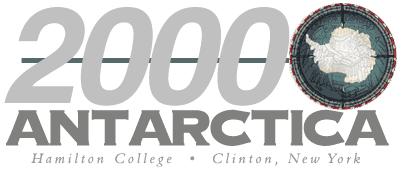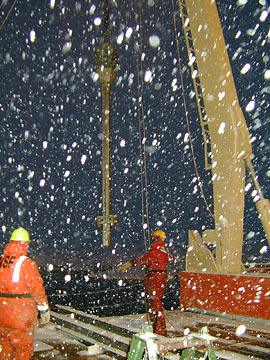
Blizzard

Shown here are MT's Matt Burke (foreground) and Mike Lewis directing Kasten core operations on the back deck at 4 am today during a raging blizzard
Current location 64 45 S, 60 18 W 3:30 pm Friday afternoon. Wild snowstorm this morning, cleared somewhat now and temperature up to 32 from a low of around zero early this morning.
After a couple of days when all we could seem to collect were rocks, we have repositioned to another part of the basin, added to our map of the structure under us and are now getting good cores. The sediment is very dense so the core, even with 550 lbs of lead, the weight on top is only penetrating 5 feet or so. This 5 feet of sediment appears to represent all the sediment that has accumulated in this area over the past 10,000 years. Throughout the cores are interesting layers; some rich with sands and gravels, suggesting ice shelf expansion and others rich with phytoplankton, which suggests that there have been periods in the past when this area was free of permanent ice.
At a good core site, a number of different sampling instruments are sent to the bottom. The standard routine is to to first send down the Benthos camera system with a CTD (conductivity, temperature and depth) meter attached. This is a bottom contact triggered camera and strobe in a special housing that can withstand the pressures at 900+ meters. It uses standard 35mm film, but we are not processing the film on board so we will have to wait until we arrive home to see the images. I think a digital version of this system is in the works if not already available. This would be great because we could bring the camera up and view the images instantly on computers which are all over the ship. Following the camera a grab sampler is sent down. This collects sediment right at the seafloor/water column interface and any critters that might be living there. The Kasten core is next and if this gives good results a gravity core is sent down. Finally the called multi core. Each of these instruments collects samples slightly differently. The kasten and gravity core are designed for penetration and collect a long column of sediment. Their large weight and speed of impact into the bottom blows away the fine sediment directly at the seafloor/water column interface. The multi corer is designed to gently collect this very fine layer. It is a computer controlled array of tubes that are slowly & gently pushed into the sediment attempting to preserve the very fine structures and characteristics of this delicate layer. Once each of these devices is brought on board, there is a scurry of activity to get them unloaded, and begin processing the samples before the samples from the next device arrive.
Students are getting great experience seeing how real cutting edge research is done. Hypotheses are constructed, tested, modified based on the data collected, re-tested and reformulated. Marine geologists, biologists, and geophysicists gather around maps and printouts of data and discuss what each is seeing in their data, if it supports the proposed model, what holes need to be filled, etc. Along with this there are the fascinating ship operations that are occurring 24 hours a day. The bridge is open 24 hours a day and the Captain and Mates are willing to explain everything from radar interpretation, navigation systems, ice piloting, etc. Out on the back deck marine techs (MT's) handle all the heavy lifting equipment, put the sampling devices over the side, and trouble shoot the constant array of problems that occur with equipment running in difficult environments 24 hours a day. Computer technicians, electronics specialists, ships engineers, the whole food service group, and numerous others all work to make it possible for the scientific investigations to occur.
Have a good weekend everyone.
Cheers,
Dave.
tewksbda@nbp.polar.org